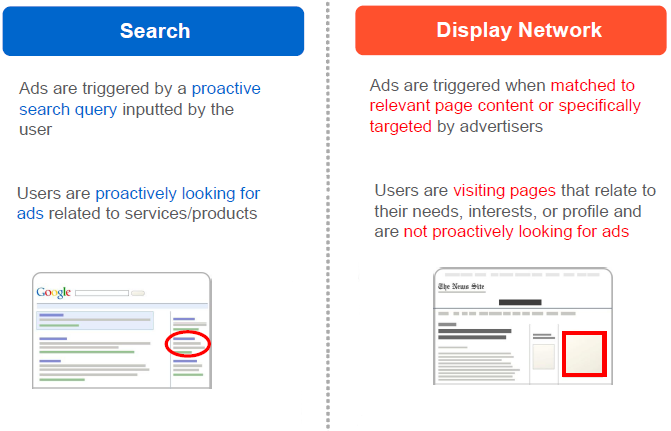Even though Google’s advertising network is well established, many brands and search marketers running pay-per-click (PPC) campaigns remain skeptical about the effectiveness of using this channel.
One of the objections we keep hearing is that advertising on the content network (or ‘contextual’ network as many prefer to call it) may be fine for a ‘brand awareness’ campaign, but not so much for a “tangible, results-oriented campaign”.
Our experience belies this, as we have found that not only can a contextual campaign deliver measurable results but it can also outperform regular keyword-driven search campaigns by several multiples.
To cite an example, we have been managing a SEM based lead generation campaign for an online education provider. The difference in results from the search campaign vis-à-vis the contextual campaign is staggering: the cost per lead generated via search has averaged at least 3 times the typical cost per lead from the contextual network; similarly, the lead-to-click conversion rate was at least double from the latter.
3 reasons to advertise on the Google AdWords content network
The stark contrasts in results described above obviously merits a deeper dive into the “why” and we can think of 3 important benefits that should make advertising on the content network of AdWords attractive for the skeptics.
1. Enormous reach:
The content network expands an advertiser’s potential reach manifold. A typical Google search result on a desktop/laptop shows a maximum of 7 ad positions (4 at the top and 3 at the bottom). On the other hand, search results on mobile show about 3 ads. We also know that the volume of search on mobile devices is now higher than volume of searches on desktop. Put all these together and one can infer that the total advertising inventory available in ‘Search’ has probably come down.
On the other hand, the number of websites and web pages that could potentially display one of your ads continues to grow, with the exponential growth of both new websites and fresh content.
In addition, the content network also increases the scope for remarketing/ retargeting, which are proving to be quite effective avenues in boosting conversions.
Therefore, not using the huge reach offered by the AdWords content network is a huge opportunity lost.
2. Flexibility with multiple ad formats
While text advertising has its own benefits, being able to deliver a marketing message in multiple formats is something that every marketer wishes for. The content network offers scope for delivering image ads/ rich media ads/ video ads, which the search network doesn’t
3. Cheaper (generally)
It probably boils down to a simple demand-supply equation, but we’ve found that in most cases advertising in the content network is significantly cheaper on a cost-per-click basis.
We’ve also noticed in several cases that the rates offered by some publishers for their advertising inventory when approached directly for a media buy are higher than getting similar inventory through the content network. Why publishers would adopt such a pricing strategy is open to debate, but from an advertiser’s perspective it is a great incentive to target those publications through the Google content network (placement targeting / managed placements).
Legacy concerns with content network advertising
A lot of the skepticism with advertising on the Google content network, I believe, is due to legacy issues. For one, it is not “intent-driven” unlike advertising on Google search. Hence, some advertisers believe that this is no different from any form of passive advertising, where the advertising is relying on some form of interruption, impulse, or mere serendipity to get the desired outcome from the advertiser.
That may be true to quite an extent but the results indicate that there are benefits of such “passive advertising”. The visitors or leads one attracts through such campaigns may have to be ‘nurtured’ differently as they could be at a different stage along the buying funnel, but it may be a folly to just ignore the opportunity to reach such an audience.
Another reason for the reluctance to invest marketing rupees in the content network could be historical results. Chances are that one has tried the network, generated clicks but not gotten sufficient leads/ conversions at acceptable cost levels. However, as Google has come down heavily on dubious sites in its search results in the past few years, the quality of sites that drive clicks can generally be deemed to be much better and relevant than they may have been previously. (this is not to say that poor quality sites, made predominantly with the purpose of displaying ads from Google don’t show up in search results now, they still do! The frequency with which one spots such sites has gone down quite a bit.).
Be open to the contextual network
As an advertiser with a limited search marketing budget, it is understandable that the default thinking is to target the search network only.
However, I encourage marketers to change that default thinking and be open to the idea of using both content and search, or even just the content network, depending on the specific objectives of a particular campaign. We’ve seen some of our clients benefit from this change of mindset, and you could too!
- By Manoj Aravindakshan
Manoj Aravindakshan is Managing Director of On Target Marketing Solutions, a Navi Mumbai digital marketing agency, specializing in search engine marketing and social media marketing. On Target helps clients across different industries/verticals plan, execute and manage Google AdWords pay-per-click advertising campaigns.
